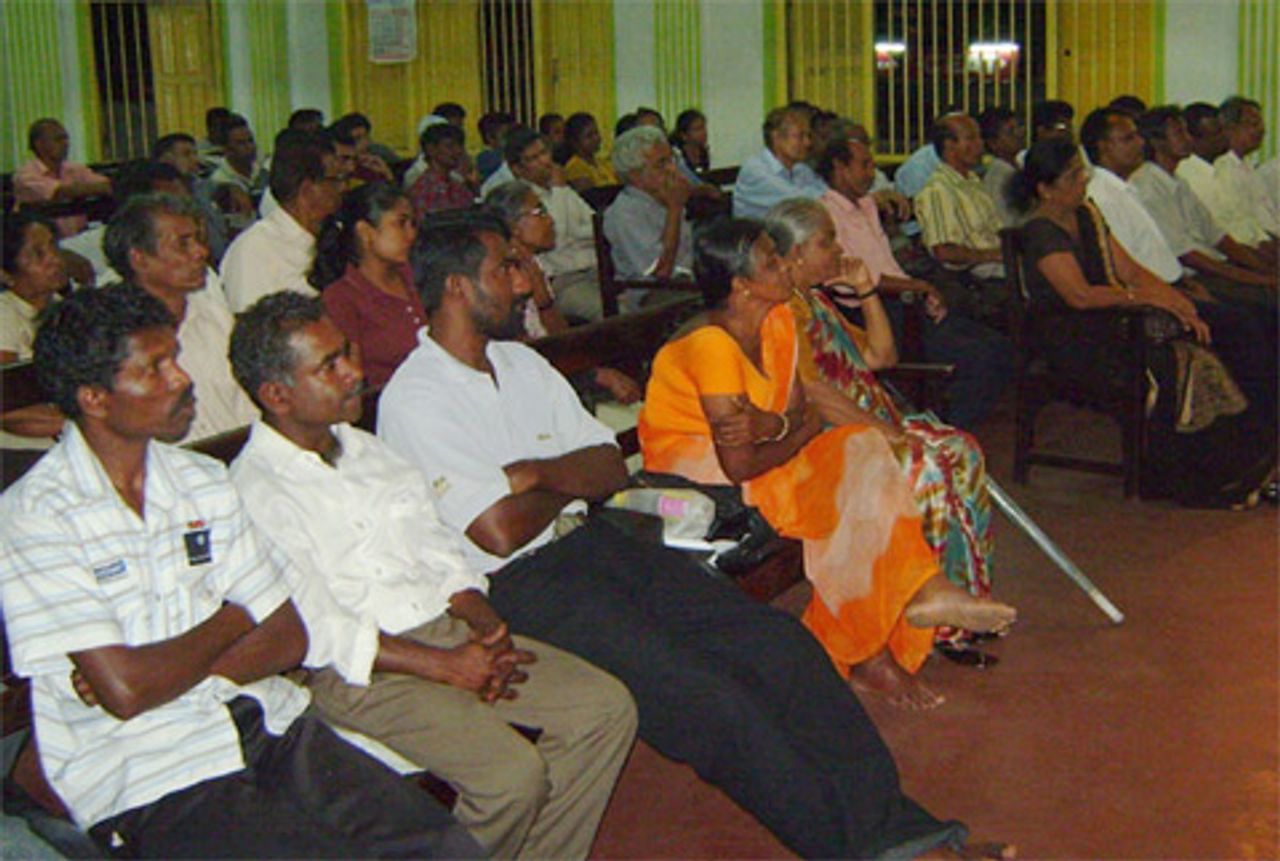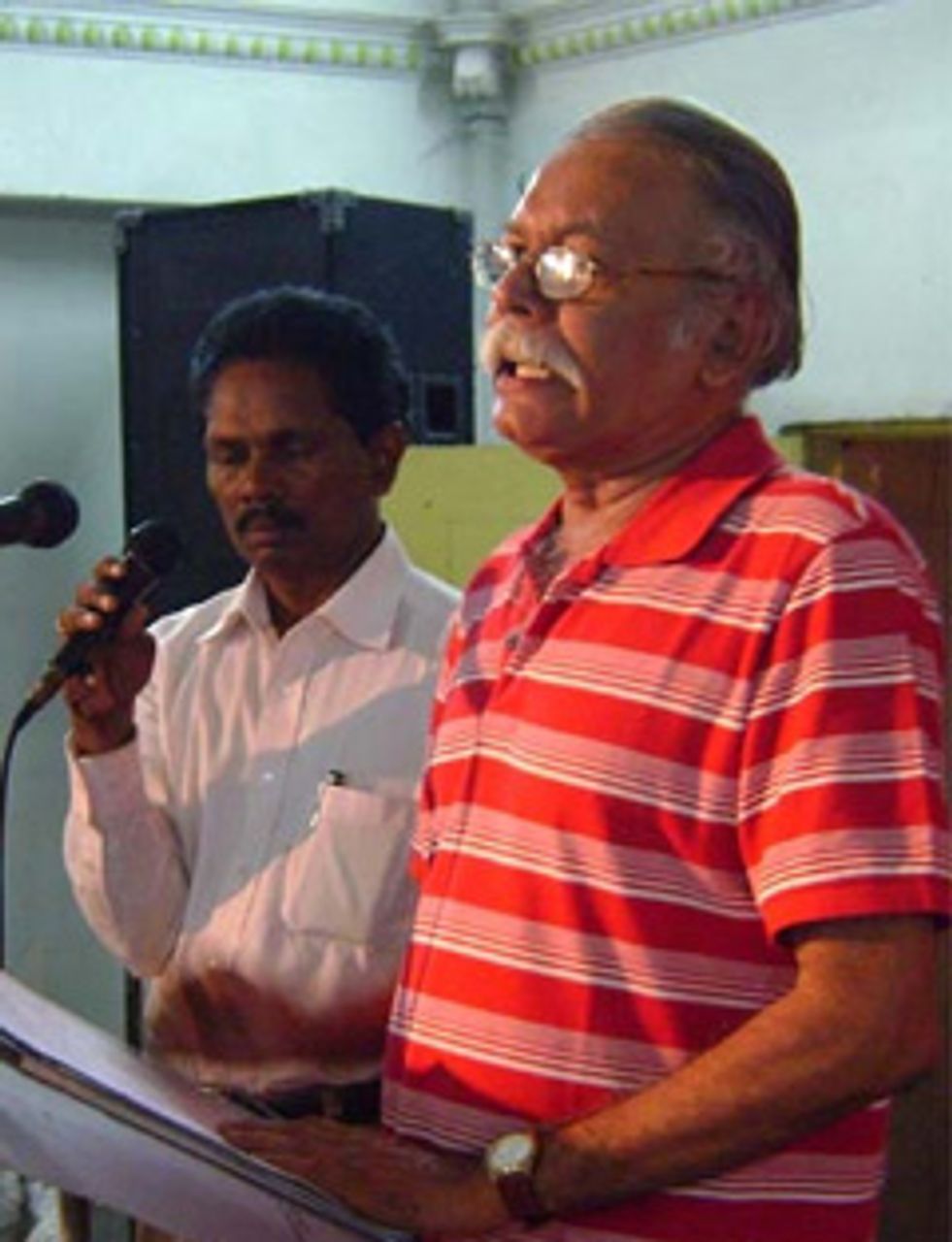The Socialist Equality Party (SEP) in Sri Lanka launched its campaign for the January 26 presidential election with a public meeting at Narayana Guru Hall in central Colombo on December 12. Around 100 workers, youth and housewives participated in the meeting which was called at short notice.
Wije Dias, the party’s presidential candidate and general secretary, was the keynote speaker. Chairing the meeting, K. Ratnayake an SEP political committee member, outlined Dias’s long record as a Trotskyist, fighting for the interests of the working class.
“There are only two sides contesting the coming election,” Ratnayake explained. “On the one side, President Mahinda Rajapakse and General Sarath Fonseka are the candidates of ruling elite, and there are several others, including the Nava Sama Samaja Party and United Socialist Party, associated with the ruling elite. Dias stands on the other side, advancing the socialist alternative.”
Ratnayake pointed to the consequences of the protracted communal war against the separatist Liberation Tigers of Tamil Eelam (LTTE). The government confronted a deepening economic crisis, intensified by continued huge military spending, and increasing resentment among workers and youth.
 A section of the meeting
A section of the meetingThe meeting chairman warned that while the opposition United National Party (UNP) and Janatha Vimukthi Peramuna (JVP) were trying to whitewash General Fonseka as a democrat, they were in fact backing the military’s entry directly into the country’s political life.
Kapila Fernando, the convener of International Students for Social Equality (ISSE) in Sri Lanka, outlined the problems facing students and youth. He ridiculed the government’s poster campaign featuring the slogan, “What is the aspiration of youth?” which claims to offer young people a bright future.
Fernando pointed out: “In the 2009 Advanced Level exam, 63 percent of 230,000 students qualified to enter university, but only 15 percent will be given a place. As expenditure on education has been cut, students have had to study under more difficult conditions, yet they have no decent future.”
According to conservative official figures, the country’s unemployment rate was 6.2 percent, rising to about 10 percent among women. “The rate in the 15-24 age group is an appalling 35.4 percent, and even 27.8 percent of advance level and university graduates have no jobs,” Fernando said. “One reason for high unemployment among young females is the closing down of garment factories due to the global financial crisis. This is what capitalism has done to the ‘aspirations of youth’.”
Fernando pointed out that the opposition Janatha Vimukthi Peramuna (JVP) was now appealing to youth to support General Fonseka, one of the military leaders responsible for the murder of more than 60,000 rural Sinhala youth in the 1988-89 period. He appealed to young people to turn to socialist politics as the only means of addressing the deepening social and economic crisis produced by capitalism.
SEP Political Committee member M. Thevarajah, who addressed the meeting in Tamil, emphasised that only the SEP had consistently opposed the communal war and c ontinued to demand the unconditional withdrawal of the armed forces from the island’s north and east. “We said not a man, not a cent for the war. We also opposed the LTTE’s bourgeois perspective for a separate state. The SEP’s fight is based on uniting Sinhala, Tamil and Muslim workers on a socialist basis.”
 Wije Dias speaking
Wije Dias speakingWije Dias began his speech by explaining that the SEP’s campaign was part of the fight to mobilise the working people, youth, rural poor and other oppressed people on a program of socialist internationalism. It was, he said, the only means of finding solutions to the burning democratic and social problems of the masses.
Dias pointed out that Rajapakse and Fonseka were partners in the murderous war that Rajapakse renewed within six months of taking office in 2005. The candidate exposed the efforts of the opposition parties to present the former military chief as a defender of democracy and human rights. Neither camp had any regard for democracy, Dias stressed. “They are simply in conflict about the best tactical means for establishing a police state to ruthlessly suppress the resistance of the working people, as was done in the war against the Tamil minority.”
Dias explained that this was an international phenomenon. “As the capitalist world passes through the greatest recession since the Depression of the 1930s, inter-imperialist rivalries have intensified, leading toward a third world war. Preparations for military conflicts go hand in hand with suppression of democratic rights at home. Barack Obama, who promised “change”, is escalating the war in Afghanistan and extending it to Pakistan while the homeland security apparatus is being strengthened against the American people.”
Dias said that the political and social challenges faced by the working people and the rural poor in Sri Lanka were similar to those of the working people throughout the globe. “They call for an international socialist solution,” he explained.
Although communal war ended in May, none of the problems that caused the war had been addressed. Around 300,000 Tamil civilians were arbitrarily detained in squalid camps surrounded by barbed-wire fences and guarded by the military. This was an explicit example of the historic inability and refusal of the ruling elite to produce any democratic solution to the problems of the national minorities.
Dias noted that Rajapakse might have calculated he would win an early presidential election by exploiting the war victory but the extent of the economic crisis overtook his subjective calculations. The huge loans to finance the war had to be paid. Total government loans have reached 4,023 billion rupees ($US350 million), or 90.5 percent of GDP, he said. “Debt servicing consumes almost the total annual income of the government.”
During the first 10 months of this year, the country’s export income had declined by 16.8 percent. The government had desperately sought a loan from the International Monetary Fund, but the $US2.6 billion loan came with drastic conditions, including the reduction of the budget deficit by 4 percent in two years.
“This means that the government must take highly unpopular decisions,” Dias noted. Already, hundreds of thousands of workers from the ports, electricity and water boards and petroleum had started to agitate for pay hikes. On top of them came the struggle by 500,000 plantation workers for a wage increase.
“The trade unions betrayed and sabotaged these struggles but the mood of the workers is growing against the government and the unions. This was reflected in the favorable response won by the SEP from the plantation workers of the Balmoral Estate to its proposal to form an action committee independent of the unions and on a socialist program to achieve their demands.”
Rajapakse had called the early election to strengthen the hands of his cabal of cronies who rule the country, Dias explained. Fonseka, on the other hand, was a Bonapartist candidate, seemingly standing above the contending class forces and without any party affiliation and not subject to party discipline. The general’s main support base was the military top brass.
Turning to the big business promotion of Fonseka, Dias noted: “His first public address after the military’s victory was to a forum of top businessmen, who invited him to explain the methods he used to win the war. Their concern was how to win the ‘economic war’ against the working class. Fonseka has indicated that he will follow the right-wing UNP’s free-market economic policy.”
The discredited UNP and JVP had latched onto Fonseka as a common candidate to avoid a humiliating election defeat. Dias insisted that working class had to reject the military candidate who was being “veiled with democratic dresses”. However, workers could not limit themselves to a mere rejection of Rajapakse and Fonseka. They had to turn to a new program and perspective.
Dias related Obama administration’s policies in South Asia to a recent report by the US Senate Foreign Relations Committee that emphasised Sri Lanka’s strategic importance for the US. The report had noted that the Rajapakse government was developing ties with China, Burma, Libya and Iran—ties that the US considered unfavourable.
With the US intent on defending its economic and strategic interests, Dias emphasised, it was the responsibility of working class to prevent Sri Lanka and the Indian Ocean from becoming a battlefield of imperialist war. He added: “This is not a task that can be achieved by the Sri Lankan working class alone. It requires international unity with the South Asian working people.”
Dias said the ex-radical candidates like Wickramabahu Karunaratne of the Nava Sama Samaja Party (NSSP) and Siritunga Jayasuriya of the United Socialist Party (USP) were utterly hostile to this unity of the working class and the fight for its political independence. Dias quoted from an Irida Lakbima column by Karunaratne, where he wrote that if the “left” received a larger vote it could work for new programs. “In other words, he intends to apply pressure to either Rajapakse or Fonseka. This is a continuation of the Lanka Sama Samaja Party [LSSP] policy in 1964 of entering into a bourgeois coalition government.”
Dias warned that regardless of whether Rajapakse or Fonseka took office, the working class would face deep attacks. He urged workers to reject the opportunist politics of the NSSP and USP, and join the SEP to build it as a mass party to fight for a workers’ and peasants’ government—a Socialist Republic of Sri Lanka and Eelam—as part of the fight for socialism in South Asia and internationally.
A collection for the party’s election fund received 15,000 rupees—more than a month’s pay for many workers. A number of people signed up to support the SEP’s campaign and take part in further discussion on the SEP’s perspective.
